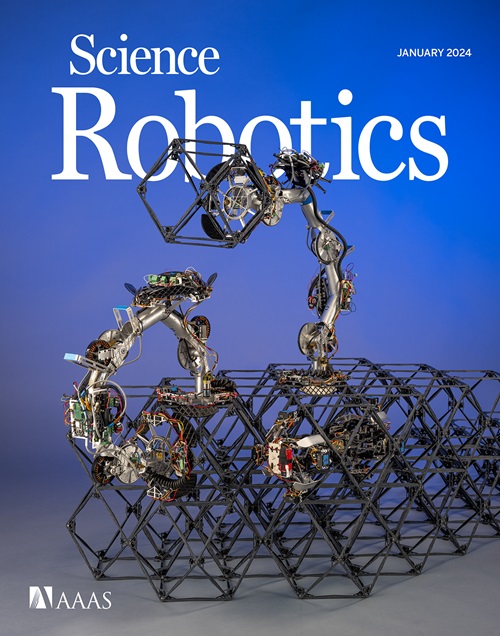Effect of hip abduction assistance on metabolic cost and balance during human walking
IF 26.1
1区 计算机科学
Q1 ROBOTICS
引用次数: 0
Abstract
The use of wearable robots to provide walking assistance has rapidly grown over the past decade, with notable advances made in robot design and control methods toward reducing physical effort while performing an activity. The reduction in walking effort has mainly been achieved by assisting forward progression in the sagittal plane. Human gait, however, is a complex movement that combines motions in three planes, not only the sagittal but also the transverse and frontal planes. In the frontal plane, the hip joint plays a key role in gait, including balance. However, wearable robots targeting this motion have rarely been investigated. In this study, we developed a hip abduction assistance wearable robot by formulating the hypothesis that assistance that mimics the biological hip abduction moment or power could reduce the metabolic cost of walking and affect the dynamic balance. We found that hip abduction assistance with a biological moment second peak mimic profile reduced the metabolic cost of walking by 11.6% compared with the normal walking condition. The assistance also influenced balance-related parameters, including the margin of stability. Hip abduction assistance influenced the center-of-mass movement in the mediolateral direction. When the robot assistance was applied as the center of mass moved toward the opposite leg, the assistance replaced some of the efforts that would have otherwise been provided by the human. This indicates that hip abduction assistance can reduce physical effort during human walking while influencing balance.
髋关节外展辅助对人体行走过程中代谢成本和平衡的影响。
在过去的十年里,使用可穿戴机器人提供行走辅助的情况迅速发展,机器人设计和控制方法在减少活动时的体力方面取得了显著进步。步行努力的减少主要是通过在矢状面上辅助向前推进来实现的。然而,人类步态是一个复杂的运动,它结合了三个平面的运动,不仅是矢状面,还有横向和正面。在额平面,髋关节在步态中起着关键作用,包括平衡。然而,针对这种运动的可穿戴机器人很少被研究。在这项研究中,我们开发了一种髋关节外展辅助可穿戴机器人,提出了一个假设,即模拟生物髋关节外展力矩或力量的辅助可以降低行走的代谢成本并影响动态平衡。我们发现,与正常步行条件相比,具有生物力矩第二峰值模拟特征的髋关节外展辅助可将步行的代谢成本降低11.6%。援助还影响了与平衡有关的参数,包括稳定幅度。髋关节外展辅助影响重心在中外侧方向的运动。当重心向另一条腿移动时,机器人进行了辅助,这种辅助取代了原本由人类提供的一些努力。这表明髋关节外展辅助可以减少人类行走过程中的体力劳动,同时影响平衡。
本文章由计算机程序翻译,如有差异,请以英文原文为准。
求助全文
约1分钟内获得全文
求助全文
来源期刊

Science Robotics
Mathematics-Control and Optimization
CiteScore
30.60
自引率
2.80%
发文量
83
期刊介绍:
Science Robotics publishes original, peer-reviewed, science- or engineering-based research articles that advance the field of robotics. The journal also features editor-commissioned Reviews. An international team of academic editors holds Science Robotics articles to the same high-quality standard that is the hallmark of the Science family of journals.
Sub-topics include: actuators, advanced materials, artificial Intelligence, autonomous vehicles, bio-inspired design, exoskeletons, fabrication, field robotics, human-robot interaction, humanoids, industrial robotics, kinematics, machine learning, material science, medical technology, motion planning and control, micro- and nano-robotics, multi-robot control, sensors, service robotics, social and ethical issues, soft robotics, and space, planetary and undersea exploration.
 求助内容:
求助内容: 应助结果提醒方式:
应助结果提醒方式:


